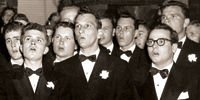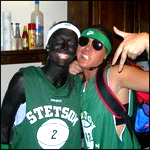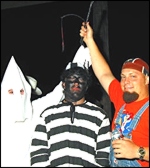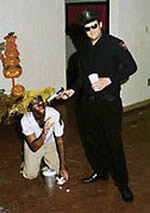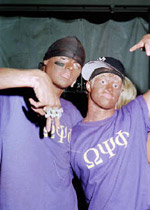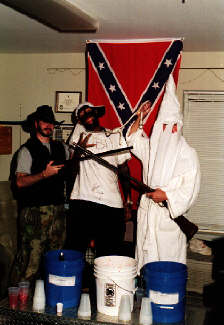Thanks again, bro: Sigs at Whitman College go “above and beyond what other people do” for Halloween… with blackface Halloween costumes
(Story thanks to a tip from TL.
)
Just about every year, right around now, I get to hear the same thing again: a bunch of students, most of them white, threw a party involving blackface costumes and other forms of crude racist caricature. It happened at Auburn–at least twice. It happened at Ole Miss. It happened at Syracuse. It happened at Oklahoma State. It happened at Stetson. It doesn’t always happen at a fraternity party, but it often does. Sometimes the kids opt for broad pastiches of
gangstaimages that they’ve picked up from MTV. Sometimes they opt for explicit references to the history of slavery and militant white supremacy. Sometimes–as it seems happened in Baltimore–they opt for both. The pattern is established, and the reactions are reliable. While University administrators are busy rushing to make a public example of whoever was caught throwing the party, and anxiously insisting (to anybody who cares to listen) that this is an isolated incident, not representative of the campus culture, etc. etc. etc., it’s left to those who know something about what actually goes on on campus (usually Black students or faculty) to point out, yet again, that these things happen in a broader context, that this is nothing new, that things like this happen all the time on campus, and that the only thing special about this case is that the story went public. Then a few months later, everything settles back down, the administration eases or completely reverses its disciplinary actions against the fraternity, and we wait until late next October or early next November, when exactly the same damned thing happens at yet another Halloween party somewhere else.… Thanks a lot, guys. You have officially ruined Halloween.
— GT 2006-11-03: Thanks, bro: a
racially themedfrat party at Johns Hopkins University
In case you were wondering, it’s still that time of the year, and the brothers of Sigma Chi have continued their tradition of leadership and service–not only at Johns Hopkins, but also at Whitman College in Walla Walla, Washington:
Walking into the Survivor-themed greek party, Sigma Chi juniors Brice Crayne and Bryan Ponti could never have imagined the kind of reaction their costumes would ultimately get. They said later that they just wanted to stand out: and with their faces and bodies painted entirely black with orange markings, they certainly did. It didn't strike them that their body paint would eventually move the entire campus to a standstill.
Senior Natalie Knott was browsing the Internet in the library when she came across photographs of Crayne and Ponti from the party. Feeling a gut reaction, Knott showed the pictures to a few friends who didn't see much controversy.
I had to leave the library because I was really angry but I couldn't figure out why because nobody was seeing what I saw,Knott said. She drew connections to racist archetypes, specifically the blackface minstrel shows popular in the early 1900s. After speaking for hours about the issue with friends in her apartment complex, Knott decided she should bring her concerns to a faculty member.The next day, Knott consulted with Politics Professor Bruce Magnusson, who told her that she should show the photographs to the dean. After conferencing with student life committee chair Clare Carson for an hour, Knott decided to post her thoughts to the student listserv, at Carson's suggestion.
The response was immediate. Feedback poured in over the listserv from minority students who felt offended, white students who felt attacked and a slew of others whose feelings fell somewhere in the middle.
— Sophie Johnson, Whitman College Pioneer (2006-10-26): ‘Blackface’ incident ignites campus
As a side note, I don’t have access to FaceBook, so I haven’t seen the photo. If any of y’all out there can find them, please feel free to pass them along to me–I think it’s important that these images be brought out into the open for public discussion.
Meheret Debebe, 19, a Whitman sophomore, said she was more offended by what she read in the listserv than by the picture.
I thought wow, I go to school with a lot of racist people,she said.Debebe, who is black, said she has felt alienated at her school in the past.
— Maria P. Gonzalez, Walla Walla Union-Bulletin (2006-11-11): ‘Blackface’ incident has Whitman abuzz
The poor lil’ white boys and their buddies insist that they’ve gotten a bum rap. After all, hey, their intentions were pure as the driven snow–they just blacked up because they wanted to stand out
(for what, exactly?). Besides, who says that in their totally non-racist minds blackface had anything in particular to do with race?
The responses that resulted from Knott's initial e-mail ranged from passively curious to incensed. At first, the bulk of responses were from those who felt insulted by Knott's assertions. … Whitman's Sigma Chi president senior James Hovard was one of the first people that took issue with Knott's e-mail. Hovard heard about the e-mail from a friend, and he produced a reply that same night.
I was a little shocked and surprised because I was at that party and the thought of Brice and Bryan dressing up in blackface never crossed my mind. I know that they wore black paint, but I never thought of it as a racial issue,Hovard said.— Sophie Johnson, Whitman College Pioneer (2006-10-26): ‘Blackface’ incident ignites campus
Well, then.
Neither Crayne nor Ponti responded to the listserv e-mail, but both were personally affected by the incident.
I had to set up a punching bag in my room I was so mad,said Crayne:I felt like someone had passed judgment on me; someone had called me something I definitely am not, and that's a racist.Ponti felt similarly attacked.
The individual who pointed out everything that was wrong with the pictures did not contact either me or my good friend as to our intentions, they simply wrote their e-mail in the heat of the moment and we were caught completely off guard,he said.— Sophie Johnson, Whitman College Pioneer (2006-10-26): ‘Blackface’ incident ignites campus
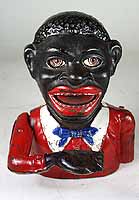
God forbid anyone should ever pass judgment on your behavior, or consider what you did apart from the esoteric of what you were feeling, deep down in your heart. Gosh but it must be so hard on them to feel attacked and misrepresented by the majority.
The students, who belong to the Sigma Chi fraternity, say they never meant to insult or offend anyone.
It was never meant to be a statement,Crayne said.We’re a couple guys who like to go above and beyond what other people do.… As for Ponti and Crayne, they have come away with a lesson.
Now that I see I offended people I’ll never do it again,Ponti said.
I can totally understand how they were offended and once I thought about it in that way I apologized. I was sorry,Crayne said.— Maria P. Gonzalez, Walla Walla Union-Bulletin (2006-11-11): ‘Blackface’ incident has Whitman abuzz
Well, that’s mighty white of them.
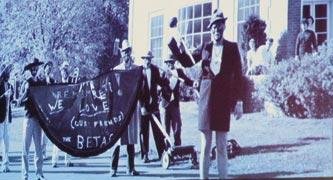
Whitman College Greeks in black face standing in front of the old student union building in the 1950s. From a presentation by Whitman professor Duke Richey. I’m sure none of them meant to make a statement.
Still, I can’t say that I’m particularly encouraged that college juniors think it’s a perfectly good excuse, in cases like these, to pass themselves off as too damned ignorant and thoughtless to be expected to know anything in particular about the history of race in America, or minstrel shows, or the use of blackface, or why folks just might not be entirely cool with it.
The faculty’s response has been relatively sensible: besides encouraging Knott to bring the FaceBook photos up with her fellow students, they’ve also cancelled a few classes to put on community events to teach about the history and implications of blackface. The administration, on the other hand, has taken this as a chance to boldly wring their hands about a PR disaster and take serious steps towards slapping the offending white frat boys on the wrist:
The costumes have since spurred heated discussions, seemingly divided the campus and prompted a Town Hall meeting that drew hundreds.
In the most recent response to the
blackfaceincident, all classes were suspended Thursday while the college held a daylong symposium on race and diversity.College takes action [sic]
In response, college President George Bridges worked with faculty and student leaders to address the tensions and to start the process of educating the campus on racial sensitivities.
Ponti and Crayne were not disciplined, but did meet with Bridges.
— Maria P. Gonzalez, Walla Walla Union-Bulletin (2006-11-11): ‘Blackface’ incident has Whitman abuzz
I’m glad they got their talking-to and all, but I can’t say that this entirely dislodges Amanda Marcotte’s question-and-answer: Where are college kids getting this idea that they should have the benefit of having their racism and sexism coddled and protected? Obviously, that's just a rhetorical question, because I know exactly where they're getting that idea, which is from all the authority figures who coddle and protect them.
Further reading:
- Amanda Marcotte, Pandagon (2006-11-11): In Borat veritas
- GT 2006-11-03: Thanks, bro: a
racially themed
frat party at Johns Hopkins University - GT 2005-11-29: Yet another isolated incident: blackface at Stetson University
- Tolerance.org 2002-09-25: Jim Crow
Bizarre
at OK State - GT 2002-05-13: Here we go again – frat racism ad Syracuse
- GT 2001-11-14: And the other shoe drops – Delta Sigma Phi dissolved in frat racism scandal
- GT 2001-11-14: One down, one to go… – Beta Theta Pi dissolved in frat racism scandal
- GT 2001-11-09: The Context of racism at Auburn fraternities
- Tolerance.org (2001-11-08): University of Mississippi Fraternity Suspended Until 2002
- GT 2001-11-06: Virulent racism at Auburn fraternities
- Tolerance.org (2001-11-19): Hate in the News List of Campus Incidents
